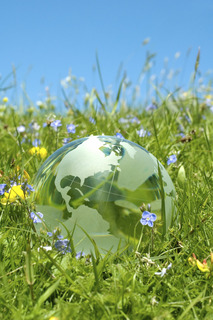Physics Gives Us an Entire Family of Effective Earth Friendly Products
Mechanical/physics-based cleaners are the original earth friendly products, and have been with us as long as we have been cleaning. In the past they were not all that effective, and so were pushed out of common use by chemical cleaners.
Some of the earliest descriptions we have of mechanical cleaning processes involve scrubbing wooden food boards with sand to clean them off. Women in primitive cultures got the dirt out of clothes by hitting them against rocks.
Talk about earth friendly products! But between the work effort, and the damage it did, it's no wonder the world moved on to other means!
Mechanical cleaning has come a long way!
Science Brings Us Microfiber
The advantage to physics-based cleaning is that it can be completely chemical free. That means no toxic exposure, and very limited environmental impact.
These earth friendly products include familiar items like scrub brushes and abrasive cleansers, and new ones like microfiber.
Abrasive cleansers clean by scrubbing things away. Without the help of chemicals, traditional abrasives can be limited in their effectiveness because of the size of the particles. Newer chemical-free abrasive cleansers are now made with very tiny particles - some so small that they polish as they clean.
Microfiber is made from synthetic fibers less than 1/6 the size of a human hair. Because of the size of the fibers, it uses a combination of absorption and van der Waals forces (forces of attraction between very small particles) to absorb oils/liquids and 'pick up' very small particles. The highest quality microfibers can even pick up bacteria, viruses, and the tiniest mold spores with only a little bit of water.
Not All Microfiber is Created Equal
There are three things you need to consider when evaluating microfiber earth friendly products:
1. The size of the fibers.
2. How the fibers are constructed.
3. How it is washed, and how many wash cycles it will withstand.

Fiber Size
Anything can call itself microfiber as long as the fiber is at least 1/6 the size of a human hair. Some manufacturers provide microfiber as small as 1/100th the size of a human hair. What's the difference?
Basically, the difference is the size of particles it can pick up without chemical assistance.
The larger fibers are not small enough to pick up or remove very small particles of dirt without chemical assistance. The smaller the fibers, the stronger the Van der Waals forces and the smaller the fiber 'hooks'.
The smallest fibers(1/100th the size of a human hair)have been hospital tested to show that they can remove even microscopic bacteria and viruses from hard surfaces using only water.
Take a look at this PDF document to see the results of microfiber studies that have been done in labs and hospitals around the world:
Click here to read the PDF in your browser, or right-click to download it.
Imagine removing pathogens without chemicals of any kind - how much better can earth friendly products be? How about the money you could save? How much simpler it is to clean.
Removing pathogens rather than killing them also reduces the risk of the development of any super bugs in your home.
Mid-sized fibers(1/45th - 1/60th the size of a human hair) can pick up fairly small particles, but need chemical disinfectant assistance to deliver the level of 'clean' provided by the fibers that are 1/100th the size of a human hair.
Anything larger that 1/30th the size of a human hair will require cleaner and disinfectant to give satisfactory results.
Since it is hard to get the fiber size from the labels, or even the internet - try this rule of thumb - if the microfiber cloth is thick and barely stretches in any direction, it is likely of the highest quality, and you can pay the higher asking price. Less expensive mid to lower quality microfiber cloths will stretch in at least one direction.
If you are considering cleaning and disinfecting without chemicals, it is best to check with the dealer or manufacturer though.
Fiber Construction
We should all want to invest in earth friendly products wherever possible, but it is important that when we do, we consider quality and effectiveness. No point in wasting money!
There are two main types of microfiber fibers. The first is the less effective polyester fiber. You may have run across this fiber in hand towels - you can tell without reading the ingredients because it doesn't absorb much water. The second is a blend of polyester and polyamide. The blended fiber absorbs both water and oil-based liquids.
There are also two ways that the fiber is constructed. The first is unsplit. Unsplit microfibers are less expensive to manufacture, but are smooth fibers that cannot easily 'pick up' and absorb dirt and pathogens from a hard surface.
Split fibers, on the other hand, have thousands and even millions of tiny hooks that capture and remove dirt, and possibly pathogens too if the fibers are small enough.
Microfiber Cleaning and Durability
Want to know how well your microfiber is made? Check the cleaning instructions.
While most very high-quality microfiber is not bleach-tolerant - all of the best microfiber should tolerate both the washer and the dryer, and water temperatures hot enough to boil water.
Cheaper microfibers may go through the washer, but not the dryer, and the really cheap ones won't tolerate either.
Mid to ultra high quality microfiber also stands up to repeated cycles through the washer and dryer - 300 and up. That means that these earth friendly products will last for years, eliminating hundreds of empty bottles and disposable pads in the land fill.
Back to
Housecleaning Products
from
Earth Friendly Products
Back to
House Cleaning
Home Page





